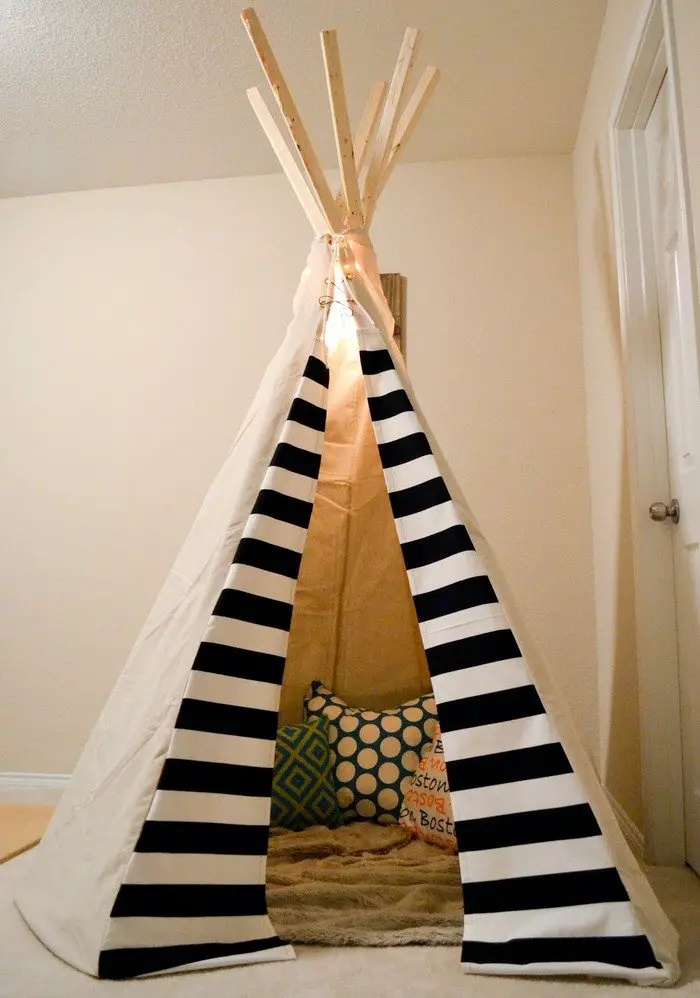
Kids love teepees! Whether it be to play inside or outside, they are great in so many ways. A teepee not only provides your kids with a cozy place to play and hide, but you can also join them there and read a story!
Have your kids been asking you for a teepee tent? Look at buying one in stores and the price can be quite expensive – considering kids will outgrow the tent in no time! Of course, you can build one yourself but not everyone is enthusiastic about the sewing part in making a typical teepee tent…

So here’s the easiest way to build one… a no-sew teepee tent! And the bonus is, you can make it as large as you want without having to spend largely as well. :)
The beautiful teepee tent featured here is big enough to accommodate three kids at once. Kids can bond and play little games on it. But it’s also a nice place to read (even for the adults)!
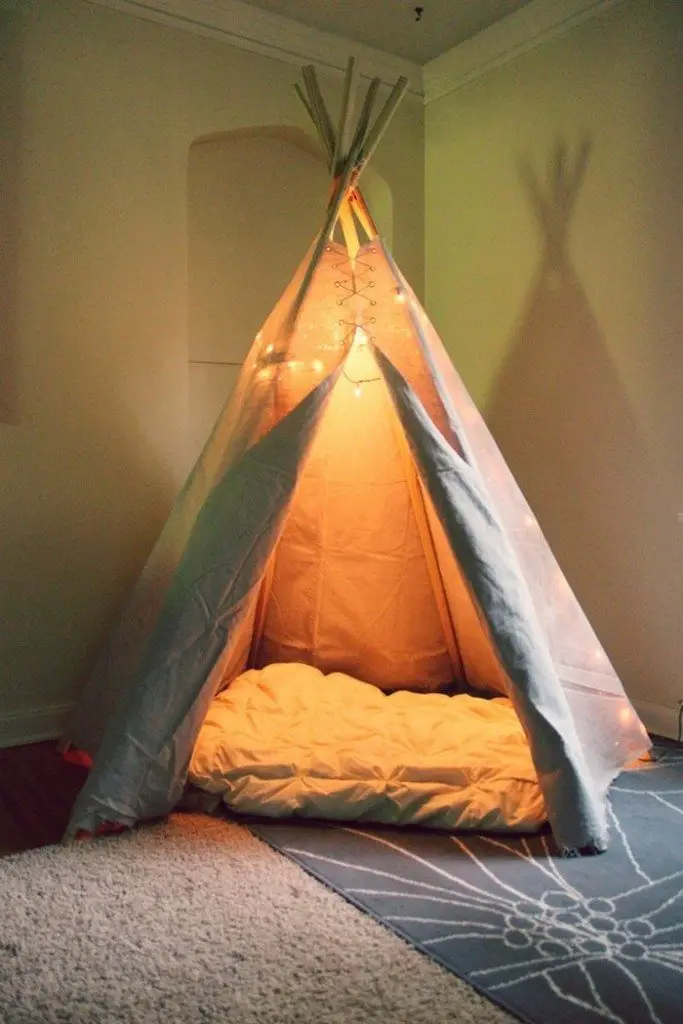
View our album of teepee tents for more inspiration. And to learn how to make a no-sew teepee tent, you can head over to a step-by-step tutorial linked below!
Is this going to be your next project for the kids?
Contents
Crafting a No-Sew Teepee Tent
Materials
- 1 x 2 x 8’ Timber
- Jute Rope
- Lots of different Fabrics (scrap or old ones)
- 1-2 Drop Cloths
Tools
- Measuring Tape
- Cordless Drill
- Hot Glue Gun
- Scissors
Instructions
Step 1: Prepare the Timber
- Measure and mark 6 inches from one end of each timber. This mark will be where you will drill a hole for the rope.
- Using the cordless drill, create a hole at each marked point.
Step 2: Assemble the Frame
- Stand the timbers upright and gather them at the drilled end.
- Thread the jute rope through the holes in all four timbers.
- Pull the rope to bring the timbers together at the top, then spread out the bases until the structure is stable and stands on its own. The ideal distance at the base depends on your desired size but aim for at least 3 feet between each timber.
- Securely tie the rope, ensuring the frame is tight and secure.
Step 3: Prepare the Fabric
- Lay out your fabrics and drop cloths. Using the scissors, cut large enough pieces to cover the sides of the teepee.
- You can keep the fabric whole for a simpler design or cut strips for a layered look.
Step 4: Attach the Fabric
- Start draping your fabrics around the frame. Begin from the top, near where the timbers meet, and work your way down.
- Use the hot glue gun to attach the top of each fabric piece to the timbers. Ensure the fabric is tight and smooth as you glue.
- Continue wrapping the fabric around the frame, overlapping slightly to ensure full coverage without any gaps.
- For a secure hold, apply additional glue at various points along the timbers.
Step 5: Customize Your Teepee
- Trim any excess fabric at the bottom with scissors for a neat finish.
- If you have different fabric patterns, mix and match them as you go around the teepee to create a fun and vibrant look.
Step 6: Add Final Touches
- Use leftover fabric or additional pieces of jute rope to add decorative elements like ties or tassels around the entrance.
- You can also add cushions, blankets, and small lights inside the teepee to make it cozy.
Click on any image to start lightbox display. Use your Esc key to close the lightbox.![]()
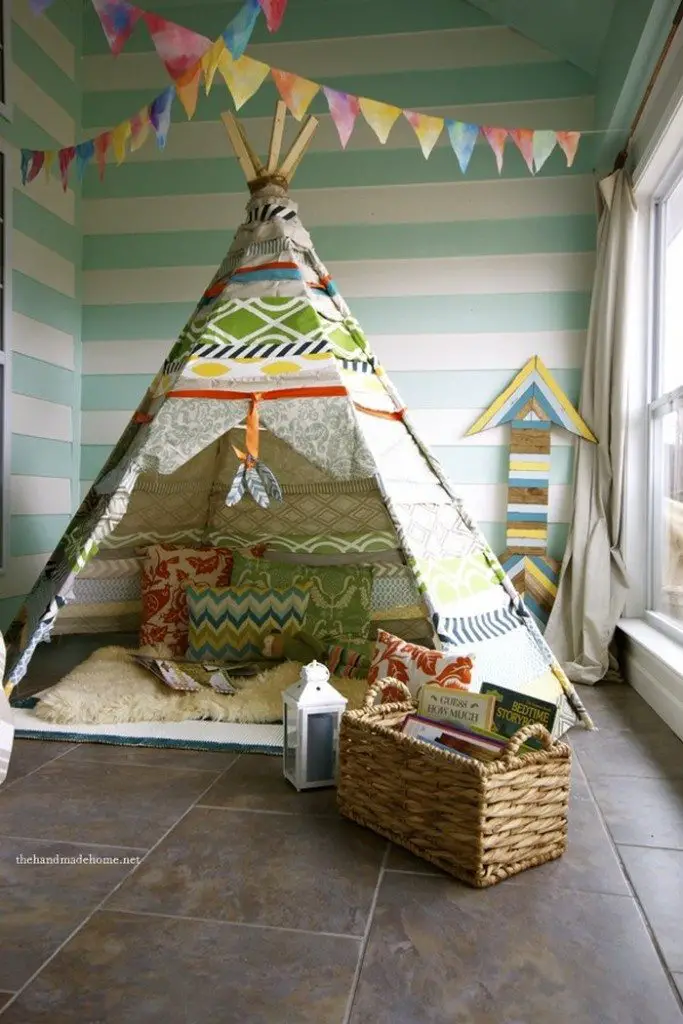

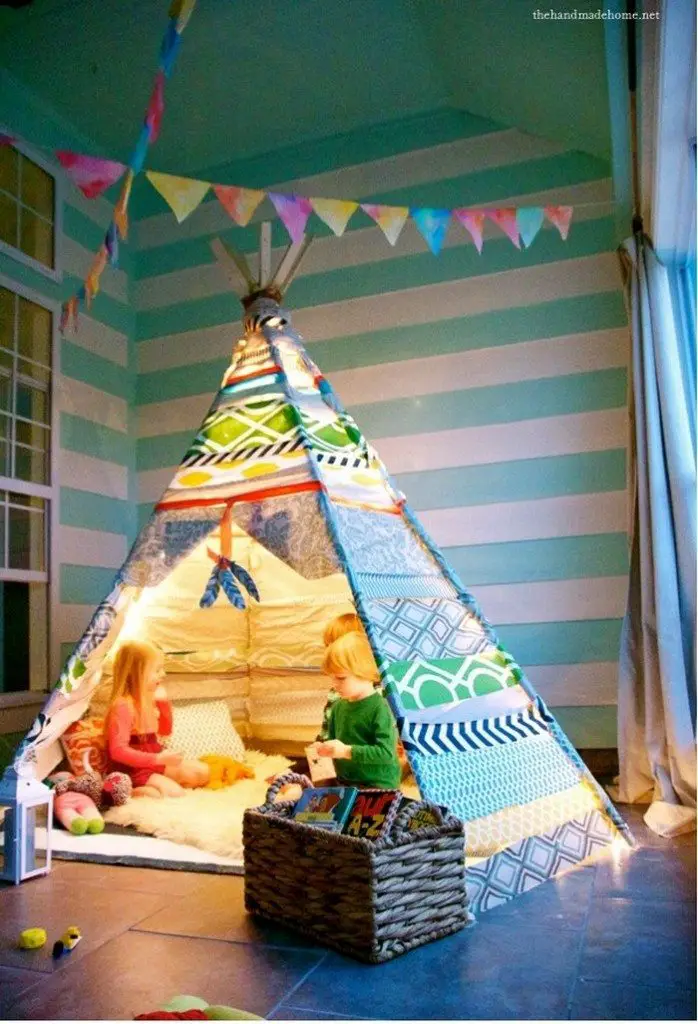
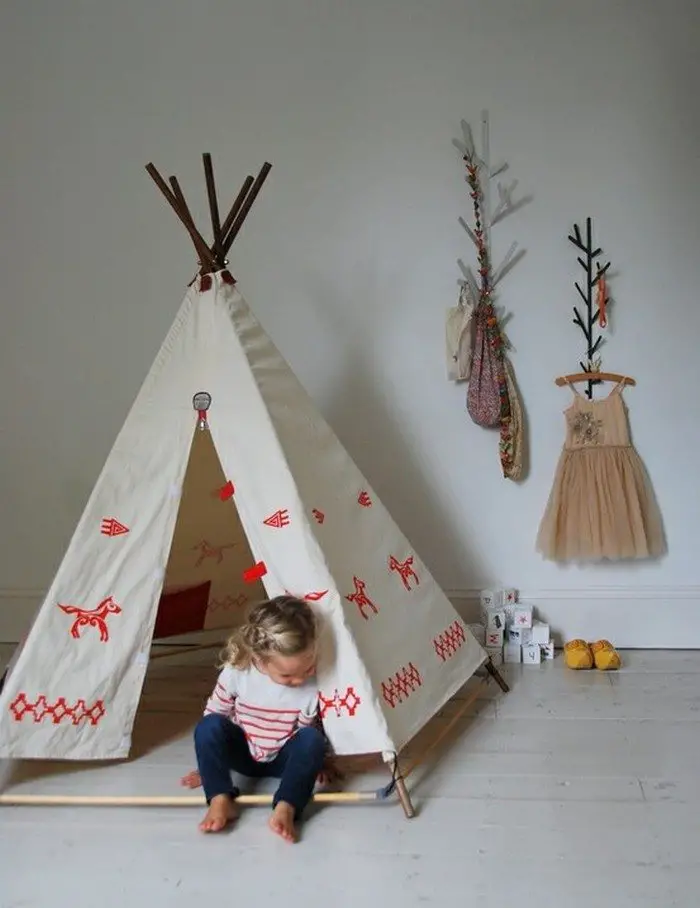
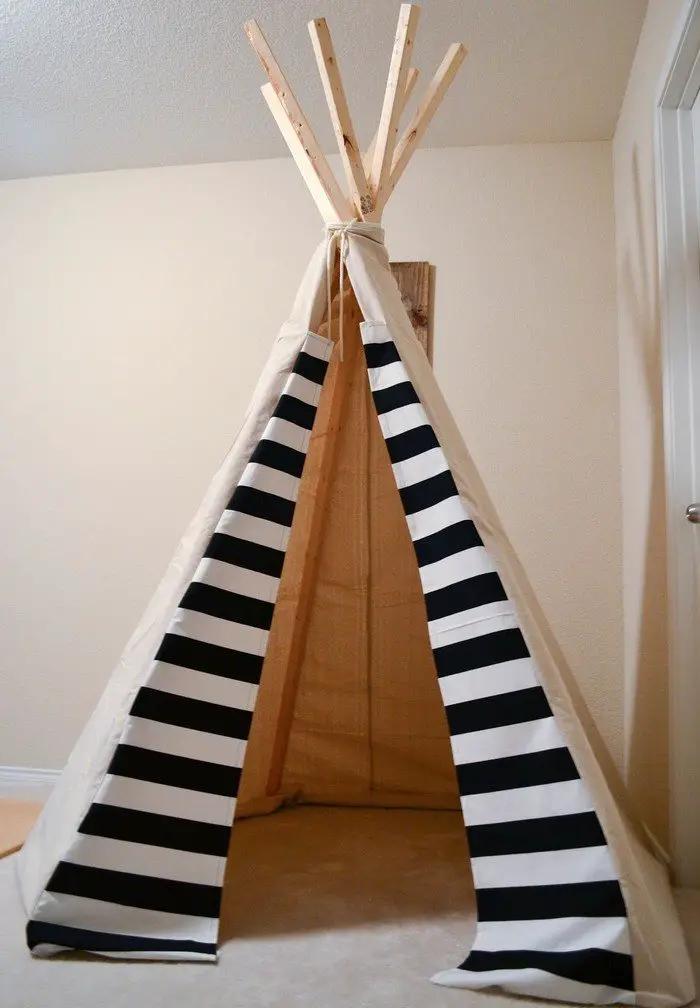

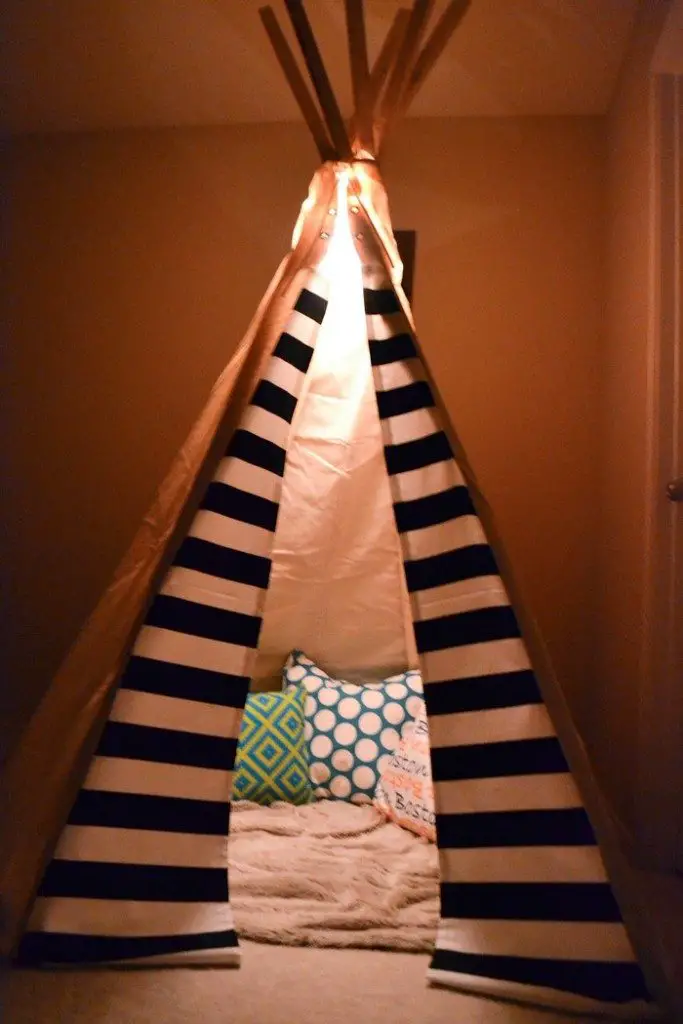

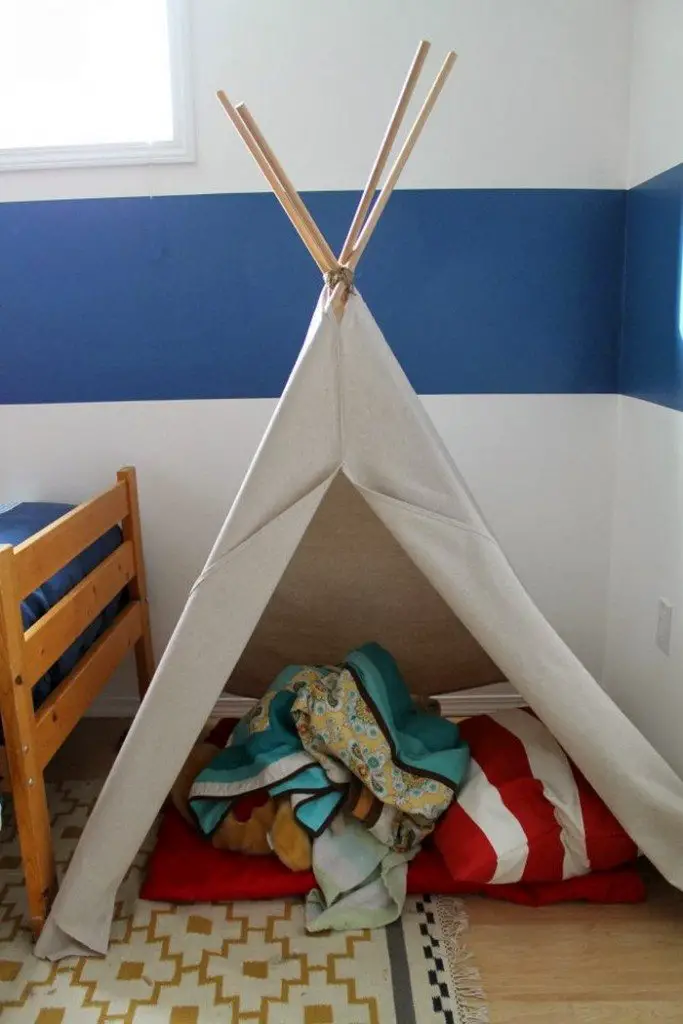
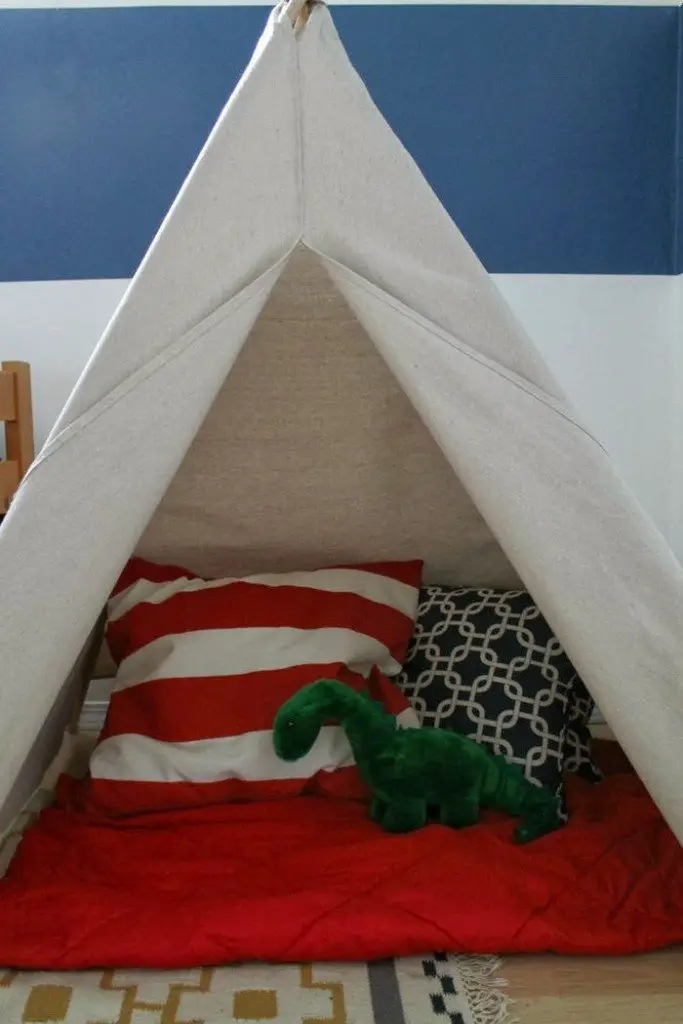
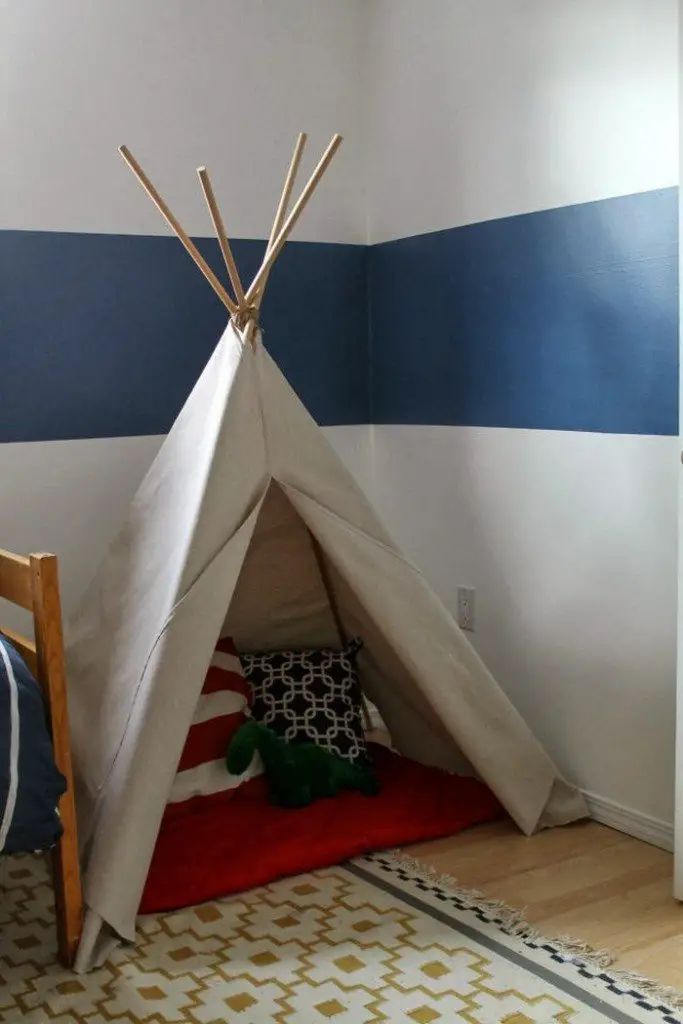
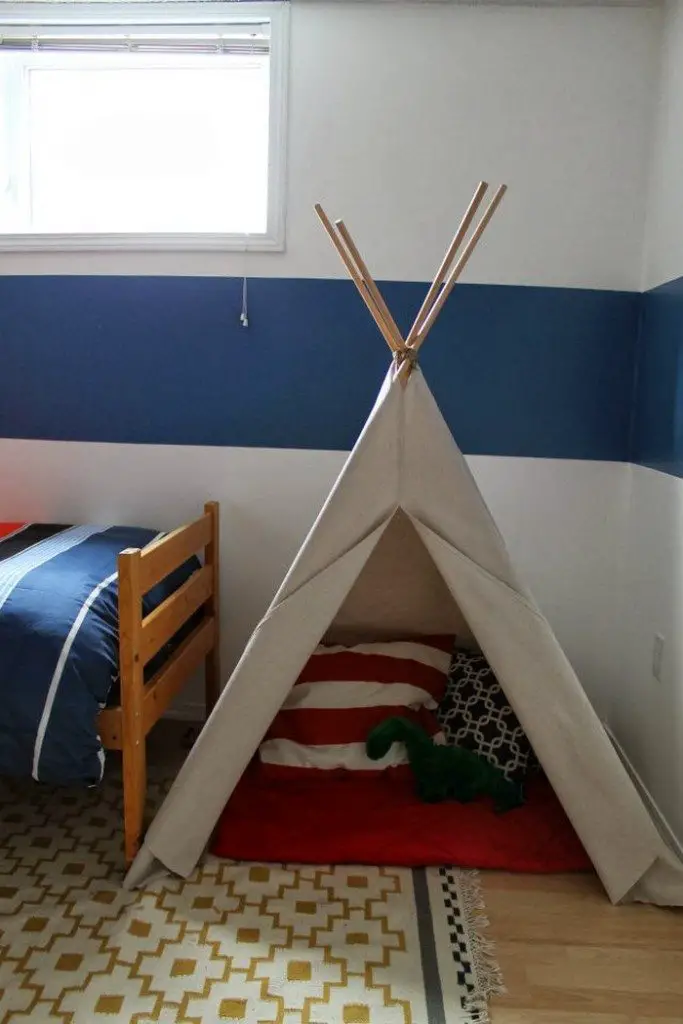
You can get step-by-step instructions from The Handmade Home over here…
Choosing the Right Materials
Choosing the right materials for your no-sew teepee tent not only ensures durability and safety but also allows for a personal touch in design and comfort. Whether you’re creating a magical play area indoors or a fun hideaway outdoors, using high-quality materials can greatly enhance the experience.
This guide will help you select the best options to ensure your no-sew teepee tent is a favorite spot for kids and adults alike.
Timber Selection
When selecting timber for your no-sew teepee tent, opt for 1 x 2 x 8’ pieces that are sturdy yet lightweight. Hardwoods like pine or cedar are ideal because they’re durable and resistant to wear. Ensure the wood is smooth and free of splinters by running your hands along each piece. If you plan to place your teepee outdoors, consider treating the wood with a non-toxic sealant to protect it from moisture and decay.
Choosing Fabrics
The fabric is the most visible part of your no-sew teepee tent, and the possibilities here are vast. For a durable and washable option, consider using canvas or cotton drop cloths. These materials are heavy enough to hang beautifully but still light enough to be safe for kids. If you’re adding decorative layers, look for soft, colorful fabrics such as cotton prints or old bed sheets which can add personality to your teepee. When selecting scraps, ensure all fabrics are clean and free from any harsh chemicals.
Jute Rope Durability
The structural integrity of your no-sew teepee tent depends significantly on the strength of the jute rope. Choose a thick, natural jute rope that can securely hold the weight of the draped fabric without stretching or fraying over time. It’s essential to select a rope that’s tough yet flexible enough to easily thread through the timber holes and tie securely.
Safety and Comfort Enhancements
To make the no-sew teepee tent safer and more comfortable, consider the texture and treatment of all materials. Opt for smooth, non-irritating fabrics, especially if sensitive skin will be in contact with the material. Additionally, ensure all materials are flame-retardant if the teepee will be used indoors or near a fire pit outdoors. This can prevent accidents and provide peace of mind.
Eco-Friendly and Allergy-Safe Options
Select organic materials and treated timbers for a green no-sew teepee tent. Particularly if youngsters have allergies or sensitivity, these materials are safer for their usage and better for the surroundings. Excellent soft and ecological options are recycled textiles or organic cotton.
Final Thought
Assemble your no-sew teepee tent such that the materials you chose not only complement your style but also satisfy your practical requirements. The correct decisions will prolong the life of your teepee and improve its usability whether it comes to making sure the cloth is easily cleaned or if the lumber can resist the elements.
Selecting the correct materials for your no-sew teepee tent can help you to build a strong, safe, and fun area loved for years. Remember, the materials you select affect not only the appearance but also the practicality of your teepee, thereby making it a popular addition to any playhouse or garden.
Safety Tips When Building and Using a Teepee
Ensuring the safety of your no-sew teepee tent is crucial, especially when it serves as a playful sanctuary for children. Both during the construction and while in use, there are important safety measures to consider that can prevent accidents and ensure a secure environment. Here’s a guide to maintaining safety standards while building and enjoying your no-sew teepee tent.
Proper Material Inspection
Before starting the construction of your no-sew teepee tent, thoroughly inspect all materials for safety. Check that the timber has no sharp edges or splinters and that all fabric is free from harmful chemicals. Avoid using small accessories or embellishments that could detach and pose choking hazards. The integrity of materials not only supports durability but also ensures the safety of those who use the tent.
Ensure Structural Stability
The stability of your no-sew teepee tent is vital to prevent it from collapsing. Secure the frame properly using durable ropes or ties at the top where the timber pieces meet. Make sure the base of the tent is spread out evenly and firmly to balance the structure. Regularly check the knots and fastenings for any signs of wear or loosening that could compromise the teepee’s stability.
Safe Play Environment
Once the no-sew teepee tent is set up, it’s important to establish a safe play environment. Place the teepee in a clear area away from high traffic zones to minimize the risk of accidental knocks. If the tent is outside, keep it away from fire pits, barbecues, and pools. Indoors, ensure it’s not too close to furniture or appliances that could pose risks. Teach children how to enter and exit the teepee safely to avoid trips and falls.
Regular Maintenance and Supervision
Continuous maintenance is key to ensuring the long-term safety of your no-sew teepee tent. Inspect the tent regularly for any tears, loose components, or potential hazards. If the teepee is used outdoors, check for issues caused by weather conditions such as dampness or mold. Always supervise young children while they play in or around the teepee to ensure they are using it safely and not engaging in rough play that could destabilize the structure.
By following these safety tips, you can ensure that your no-sew teepee tent remains a secure and enjoyable play area for children. Regular checks and mindful setup go a long way in creating a safe space that encourages fun and imaginative play.
Conclusion
Creating a no-sew teepee tent presents an interesting and artistic endeavour for adults and children alike. Using the correct tools and emphasizing safety will help you to design a safe and comfortable play place that stimulates imagination. Appreciate the procedure and the wonderful times of leisure and play your homemade tent will offer to your house.
We have more fun projects for kids. Check out our play kitchen project next!





